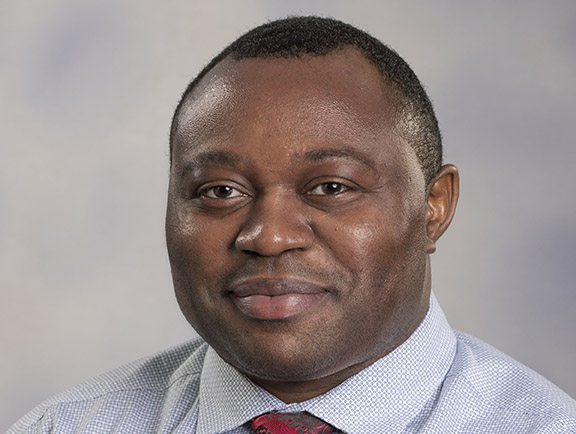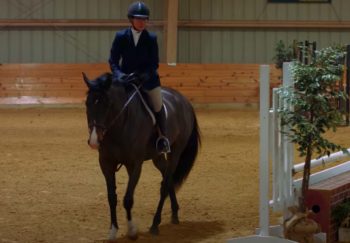When Polinpapiliñho (Poliñho) Katina, PhD, broke his leg, he was at least doing something he loved: playing soccer. “Some people hike, some people go kayak. For me, it was playing soccer,” he said. That love turned into a major setback. When he broke his shin bone after colliding with a goalie, he had surgery to fix the break. His bone fracture never healed. After being in pain and on crutches for 9 months, he came to UVA Health and got relief with a second (revision) surgery.
When Poliñho's family came to the U.S. from the Democratic Republic of Congo in 2000, he got right down to playing. “I played soccer for Charlottesville High School. I wanted to play in college, too. In fact, I was going to go pro, but my parents said, ‘No, we think you should go to college.’”
Poliñho did go to college. He finished graduate school and was working on his PhD dissertation when he broke his leg. "Oh, I was exhausted,” he remembers. “I submitted some work. My advisor said he would look at it to give some feedback." Waiting for the feedback, Poliñho headed to a local soccer field.
"Everything was OK, until I got tackled by the goalkeeper," Poliñho says. "Just in an instant, I had the ball to go score, the goalkeeper comes and takes me out, and that was it.” The compound fracture broke both his tibia and fibula.
First Attempt at Healing Fails
Unfortunately, his situation turned serious. His broken leg needed more than just a simple cast. “My right leg began to swell,” recounts Poliñho. “What they ended up doing was to slice on the outside of my leg to release the pressure. To fix the bones, they had to go through the knee to put in the rods. They also put two screws near the knee and two screws by the ankle.”
Although his surgeons in the Tidewater area worked hard to get his leg set up for healing, recovery wasn’t so easy. “So here is where things get strange,” Poliñho sighed. “One month goes by, and it was not healing. The doctor who was treating me would tell me, ‘You know, we don’t understand why you’re having a non-union of your bones. We should see some healing on X-rays. But we don’t see any growth.’ One month, two months … I believe six months go by. Now I’m getting frustrated.”
He says he was unable to put pressure on his leg and when holding it up, it would bend slightly in the middle of his shin – with intense pain. “At the area of the break, it would bend,” he recalls. “And it would cause a certain pain that would set me shivering so bad.”
The pain caused Poliñho to consider quitting school. “I thought ‘I can’t walk. I can’t even drive. What do I care about my dissertation?’ I felt absolutely horrible. It wasn't a good time.”
New Care for an Old Break
He knew something was wrong. He knew he should have seen some recovery much more quickly. At this point, Poliñho was getting desperate. He had reduced and then stopped his pain medication for fear that it was preventing his healing. He kept seeing the original doctor, who removed one of the screws to reduce the gap between his bones at the break. This also didn’t work. Eventually, he decided to get care elsewhere.
“Luckily, my brother’s wife worked at UVA,” Poliñho said. “My brother said, ‘There is a particular doctor that everyone says is good.’ So I drove to Charlottesville – well actually, I couldn’t drive, I got a ride! With every bump on (Interstate) 64, I was feeling pain. By the time I got to Charlottesville, I was so exhausted.”
Coming to UVA Health for a 2nd Opinion
Poliñho's sister-in-law recommended he see Seth Yarboro, MD, an orthopedic trauma surgeon at UVA Health. Yarboro recalls, “He initially had a tibia fracture and had a severe soft-tissue injury associated with it. So that was a set up for having problems healing.”
Yarboro wasted no time in spotting Poliñho’s problems. “His tibia fracture had gone on to a non-union, which means that there wasn't bony healing across the fracture. This results in ongoing pain symptoms, such as functional difficulties, and problems walking, running, and being on your feet for a prolonged period. And so, because of the problems with his bone healing, he came to see us.”
Poliñho recalls Yarboro drawing key conclusions right away, after seeing his X-rays. “He says, ‘There's something very interesting about the rod in your leg.’ He hadn’t done much work – all he had been doing was listening. But when he saw it, he said, ‘That rod there, it could be an issue.’”
Why Bones Don't Heal
To find out why the bones weren't healing, Yarboro looked at:
- Fixation (the rod placement), and whether it needed to be changed or revised
- Lack of stability
- Lack of blood flow
Other factors that could cause non-union include:
- Metabolism
- Nutrition
- Infection
About Poliñho’s injury, Yarboro notes that Poliñho suffered compartment syndrome at the time of his break. Compartment syndrome is damage caused by pressure building up from swelling. It can stop blood flow. Yarboro explains, Poliñho "had to have compartment releases, which create big wounds on the leg. There's an open wound aspect to the injury then, and that can impact healing. And, the tibia itself is notoriously slow for healing, but other metabolic factors, such as low vitamin D and nutritional issues can affect bone healing as well.”
Then, using a CT scan to see how much bone still needed to heal, Yarboro recommended a revision surgery called an exchange nail procedure. This meant replacing the previous implant with a larger rod.
This type of revision surgery could stabilize Poliñho's leg. “The good news is, it's more stable and patients can often walk on it soon afterward, depending on their symptoms,” said Yarboro. “Rehab consists of ongoing mobility, as the patient is able, and monitoring for infection.”
Poliñho was excited to move forward. Yarboro told him he'd be up and walking within a few days. But he still was skeptical. He'd been on crutches for almost 9 months.
Getting to Better: Revision Surgery
Regarding the rod from Poliñho’s previous surgery, Yarboro doesn’t think there had been a mistake. “It’s not that it was the incorrect size,” he said. “It may have been appropriate at the initial surgery."
What Yarboro points out reflects the expertise of a surgeon who has done revision surgeries for injuries like this for years. The larger rod encourages healing because it increases stability. In addition, "The procedure for reaming bone to make room for the new implant encourages healing,” said Yarboro.
Pain From an Injury?
Lingering pain can be a sign that recovery isn't going as planned. UVA Health orthopedic specialists can provide a second opinion on your treatment.
Finally Driving to Recovery
The second time around, Poliñho’s recovery went much better. “I went in to have the surgery, and it was one of those where they do it and the same day they release you,” recalls Katina. “One day, two days, and by the third day I was actually able to hop around the house without the crutches!”
“To me, that was unbelievable! I mean, nine months on crutches and having all kinds of problems in my leg. This guy says, ‘Hey, look, we'll fix this for you. We know what the problem is.’ And within three days, I was walking around without crutches. I was super relieved,” sighed Poliñho.
Looking Better & Better After Revision Surgery
Following the revision surgery, Poliñho’s mood lifted. His brother took him back to Norfolk. Once home, feeling and moving better, he decided to keep working on his dissertation.
And his leg continued to heal.
The best news: The day the doctor told Poliñho he could exercise. “I said ‘No, I don’t think I’m ready to go play soccer.’ He said, ‘No, you’re doing much, much better now. Go ahead!’"
“Recovery from that revision surgery is usually much easier than the initial recovery from the acute fracture surgery,” said Yarboro. “Patients typically feel better very quickly after this type of non-union surgery, where we're able to take a straightforward approach to the bony problem and allow early mobility.”
For Poliñho, recovery was relief. "I went to the beach, you know, just to feel like I can walk on a beach with a soccer ball. It was a great feeling.”
“He was very motivated to get better, and very appreciative of our care. He was also highly engaged in terms of doing everything he could from a patient perspective to make sure he got back to life as usual,” recalls Yarboro.
“I felt very much welcomed,” says Poliñho about his experience getting care at UVA Health. “UVA is a big place with a lot of international representation. I felt really comfortable.”
Poliñho earned his PhD in 2015, got married, and continues to live an active lifestyle while teaching and conducting engineering research.



My husband has a broken leg with all of the same problems with nonunion healing of his tibia and fibula leg bone: He has been dealing with this for a year and 3 months He had the screws removed from top of of leg.has also used a bone stimulator for five months. His orthopedic then sent us to a bone medicine Dr after telling us no more surgery even though his leg was still broken. He is now looking at the revision surgery with bone grafting. I am just curious if you know of any goood drs in New Orleans Louisiana area that specializes in this type of surgery